BIMM House 38-42 – previously 20 Brunswick Street West
BIMM House, 38-42 Brunswick Street West, is one of the two sites of BIMM Music Institute in Brighton & Hove. Its Hove site has premises both at the top of Brunswick Street West, in what was originally the Council Chamber of Brunswick Town, and newer premises a little further down the same side of the street.
It is the new site that we are examining; what were the dramas that unfolded there before its current inception?
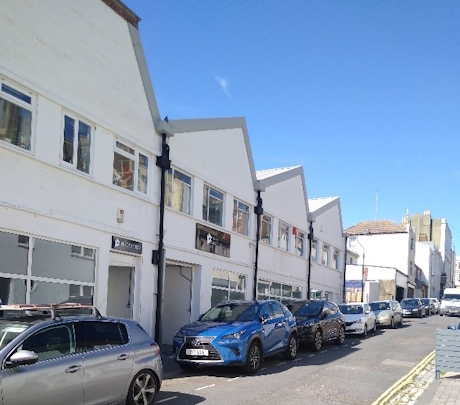
The current site from Google Streetview
The current site was only given as a numbered location from as late as the1881 census. Before then it is only the street directories and its proximity to other businesses including the Star of Brunswick pub that confirm the site exists. Between 1877 and 1881 it is simply noted as livery stables but without attribute to ownership.
In1881 it is listed as No 20. House numbers usually follow in odd or even number to each other so we might expect No 20 to be next door to No 18 or 19. et its street numbering on property plans tells us that it runs as the next-door neighbour to houses No 45, 43, 41 and then the Star of Brunswick pub.
Development plans of 1924 show the location of 20 Brunswick Street West which would have been opposite the garden of 41 Brunswick Square, now 43 Brunswick Street West. The plans show that the later 19th-century developers of that side of the street were somewhat creative in their numbering.
It appears that where a house in Brunswick Square didn’t have stables, they ‘borrowed’ what would have been its stable number and used them for the west side of the road. Hence, you can see they’ve reused 41, 43 and 45 because those houses in the square didn’t have stables, but not 40 as that one did. When they couldn’t steal a number from the other side of the road, they made one up, as with number 20, even if that number bore no relation to the rest of the street; there never were 20 buildings in the street!
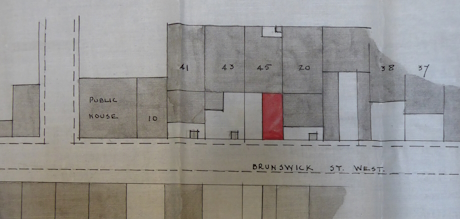
February 1924 plans for development of adjacent property. Source: The Keep
We know that by 1881 the premises were an independent business as well as residence of William Finnemore, Fly Proprietor (see 46 BSW house history). Prior to 1881 Finnemore held the same occupation at Lansdowne Mews. His location is given in vague terms by the census enumerator of 1871 as in ‘a range of buildings all adjoining without consecutive numbers’ and as ‘similar to Brunswick Mews’.
We can’t be sure why the site became No 20 but we do know it was a house number that remained out of sequence with its neighbours well into the 20th century.
The changes emerging in society in the late 19th century were reflected in the properties and people of the street. William Finnemore recruited all his grooms and stablemen from the West Country within range of Petrockstow, his place of birth. This appears to be intentional. Agricultural life was poverty stricken in the 19th century and life expectancy short. Offers of employment in the new towns gave security and opportunity for those with ambition and avoided destitution in the countryside.
As an example of support, we see that Finnemore took guardianship of a 12-year-old Eli Lake, born Petrockstow, who both lived as part of Finnemore’s household in Brunswick Town and was employed by him as a stableboy. Social security was more or less non-existent and support either by extended family or through ‘good neighbourliness’ might be the only means of survival. It appears to be no coincidence that a further 2 siblings of Eli Lake were also employed by Finnemore at No 46 Brunswick Street West. Their mother is shown as widowed and on parish relief in Devon.
Social change came not only in the form of agricultural workers taking employment opportunities in the newly emerging fashionable towns such as Brunswick Town and Hove. In 1893 shortly before his retirement Finnemore advertised the sale of his businesses at No 20 and No 46 BSW.

Finnemore’s for sale in 1893
Yet the people who followed at No 20 had other ambitions.
In 1901, the census gives George Brooker and wife residing at the premises along with their 17-year-old son, also called George, a bus conductor. Whilst George senior worked as a traditional flyman, George junior’s occupation shows how travel had become a far less exclusive facility with general transport available to all. The Brighton, Hove and Preston United Omnibus Company had been formed in 1884 to amalgamate the various horse-drawn omnibus operators.
The advance by 1901 of a tram service in Brighton meant there was competition against the omnibus. Motorised buses had started to be used in London from 1904 and were also being introduced in Brighton and Hove from then on. Thomas Tilling who owned the London bus company had bought many provincial routes and services and by 1916 owned the bus service for Brighton and Hove. By 1916, perhaps partly due to so many horses being requisitioned for use in WW1, the full fleet of Brighton and Hove omnibuses became motorised.
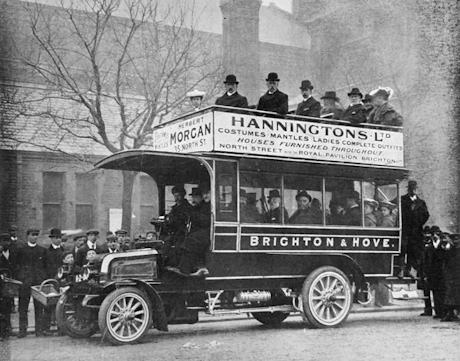
Brighton and Hove omnibus 1904 -photo from Richard Roberts archive
Returning to our property, No 20 appears to have been used on leasehold by 'jobmasters' Thomas Patrick and his uncles, William Patrick and Alfred Patrick from 1896 onwards. A jobmaster was a keeper of a livery stable who rented out horses and carriages by the week or month. The Patricks were a family of two brothers and a sister (William, Alfred and Ellen) who had moved from Hundon, Suffolk to Brunswick Town with a jobmasters business at 6 Brunswick Street West and another at Lansdowne Mews.
To say the family settled matters with a fight is reflected in some of the newspaper articles about them. Here they are in 1894 and again in1903 giving us a taste of their location, employment and lifestyle.
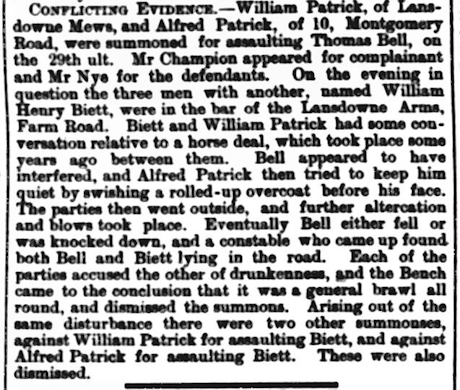
Brighton Gazette April 1894
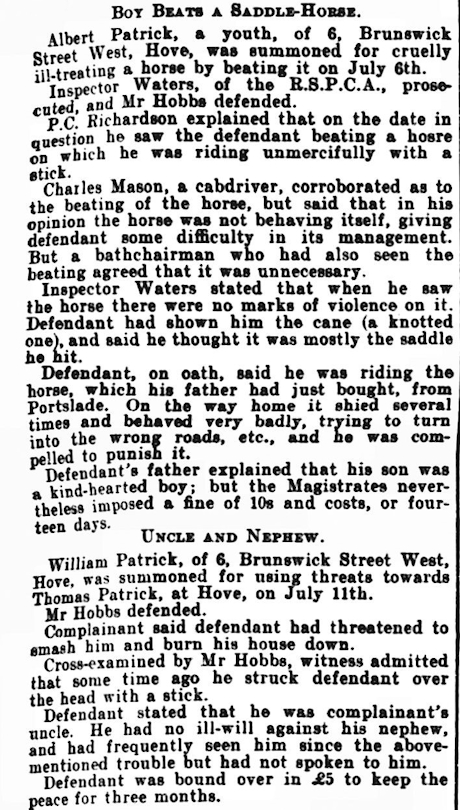
Brighton Gazette July 1903
Nevertheless, the family were moving with the times. By the 1911 census Thomas Patrick is living at 20 Brunswick Street West with his family and gives his occupation as motor cab proprietor. His planning applications in 1912 show the intention was to redevelop the site for motorised transport, covering the 26’ 6” forecourt with corrugated iron roofing and skylights to create garages. We perhaps see the similarity of this proposal to the pitched series of roofs at BIMM.
A further application by Thomas Patrick sought a gateway to the left-hand side of the premises with a wall to the remainder of the right side. A petrol-store was proposed to the right-hand side of the gateway.
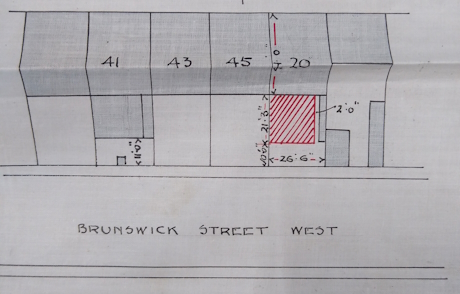
Plans for development in 1912. Source: The Keep
But not everything was going well for Thomas Patrick. For very different reasons than the ones before, by 1913 Patrick was back in court.
In what may have been one of the first of its kind, a customer injured in one of his taxis sues him for damages following an accident.
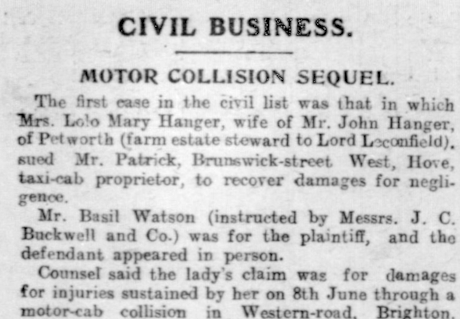
Brighton Gazette December 1913
Intriguingly, Patrick declares to the court that his business, although covered by insurance, has gone into liquidation. It is evident that he employs drivers and oversees the business. The claim against him comes more or less at the same time as he is developing the site at No 20. Was this coincidental? We do not know if the business folded and truly went into liquidation. We can’t be sure what became of the garages at No 20.
Patrick Thomas moved to Farm Road, Hove, and died there in 1929. His wife Florence appears on the 1939 Register as a widow living at 12 Farm Road. Her next-door neighbour at number 11 is 87-year-old Ellen Patrick, the eldest of the Patrick siblings who first came to Brunswick Town from Suffolk. Perhaps most surprisingly is that Thomas Patrick’s daughter Rose, now known as Rose Short, is living with her mother at No 11.
Her occupation in 1939… garage manageress.
Research by Rachel Pope (October 2023)
Return to Brunswick Street West page


